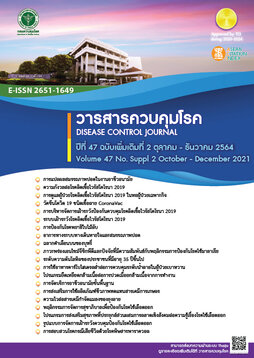ความชุกของภาวะพร่องเอนไซม์จีซิกพีดีและปัจจัยที่มีความสัมพันธ์กับพฤติกรรมการป้องกันโรคไข้มาลาเรียของนักเรียนระดับประถมศึกษาในโรงเรียนตำรวจตระเวนชายแดน จังหวัดแม่ฮ่องสอน
DOI:
https://doi.org/10.14456/dcj.2021.106คำสำคัญ:
ภาวะพร่องเอนไซม์จีซิกพีดี, การป้องกันไข้มาลาเรีย, โรงเรียนตำรวจตระเวนชายแดนบทคัดย่อ
ภาวะพร่องเอนไซม์ G6PD หากได้รับยารักษาโรคไข้มาลาเรียบางชนิดอาจเกิดอันตรายจากการแตกของเม็ดเลือดแดง การศึกษาเชิงพรรณนาแบบภาคตัดขวางมีวัตถุประสงค์เพื่อหาความชุกของภาวะพร่องเอนไซม์ G6PD และศึกษาปัจจัยที่มีผลต่อพฤติกรรมการป้องกันโรคไข้มาลาเรียของนักเรียนระดับประถมศึกษาในโรงเรียนตำรวจตระเวนชายแดนจังหวัดแม่ฮ่องสอน กลุ่มตัวอย่างอายุ 7-13 ปี จำนวน 392 คน เก็บข้อมูลโดยแบบสัมภาษณ์และคัดกรองภาวะพร่องเอนไซม์ G6PD โดยการประยุกต์ใช้ชุดตรวจฟลูออเรสเซนต์สปอทเทสร่วมกับการตรวจหาเชื้อมาลาเรีย วิเคราะห์ข้อมูลโดยใช้ร้อยละ ค่าเฉลี่ย ส่วนเบี่ยงเบนมาตรฐาน 2test และ Multiple Logistic Regression ผลการศึกษาพบว่า ความชุกของภาวะพร่องเอนไซม์ G6PD ร้อยละ 10.46 ซึ่งมีความสัมพันธ์กับเพศ ความชุกในเพศชาย ร้อยละ 13.54 เพศหญิง ร้อยละ 7.50 โดยมีความรู้เรื่องภาวะพร่องเอนไซม์ G6PD ที่ต้องแก้ไขร้อยละ 95.15 ความรู้ การรับรู้ และพฤติกรรมการป้องกันโรคไข้มาลาเรียระดับต้องแก้ไข 87.76, 55.61 และ 80.87 ตามลำดับ ปัจจัยด้านการรับรู้โอกาสเสี่ยงของการเป็นโรคไข้มาลาเรีย การรับรู้ประโยชน์ของการรักษาและป้องกันโรคไข้มาลาเรีย การรับรู้เกี่ยวกับโรคไข้มาลาเรียในภาพรวม การดูแลตนเองในภาวะปกติมีความสัมพันธ์กับพฤติกรรมการป้องกันโรคไข้มาลาเรีย (p<0.05) เมื่อควบคุมทั้ง 4 ปัจจัยที่มีความสัมพันธ์กับพฤติกรรมการป้องกันโรคไข้มาลาเรียพบว่าปัจจัยด้านการรับรู้ประโยชน์ของการรักษาและวิธีป้องกันโรคสามารถทำนายพฤติกรรมการป้องกันโรคไข้มาลาเรีย ร้อยละ 80.87 (adjusted odds ratio [OR]: 3.07, 95% confidence interval [CI]: 1.69 - 5.56, Psuedo R2 = 80.87) ดังนั้นเด็กที่มีภาวะฯ นี้ ควรแนะนำเพิ่มเติมเพื่อให้รับรู้เกี่ยวกับการหลีกเลี่ยงยา ลดการสัมผัสสารเคมี หรือสิ่งที่ก่อให้เกิดความรุนแรงต่อเม็ดเลือดแดง ดูแลให้ได้รับการรักษาที่เหมาะสมเมื่อเจ็บป่วยด้วยโรคไข้มาลาเรีย เพื่อลดอันตรายจากภาวะเม็ดเลือดแดงแตก และลดโอกาสแพร่ระบาดไข้มาลาเรียในพื้นที่
Downloads
เอกสารอ้างอิง
Sudathip P, Kitchakarn S, Shah JA, Bisanzio D, Young F, Gopinath D, et al. A foci cohort analysis to monitor successful and persistent foci under Thailand ’ s Malaria Elimination Strategy. Malar J [Internet]. 2021 [cited 2021 Apr 2];20:1-9. Available from: https://malaria-journal.biomedcentral.com/articles/10.1186/ s12936-021-03648-8.
Hotez PJ, Molyneux DH, Fenwick A, Kumaresan J, Sachs SE, Sachs JD, et al. Control of neglected tropical diseases. N Engl J Med [Internet]. 2007 [cited 2021 Apr 2];10:1018-27. Available from: https://pubmed.ncbi.nlm.nih.gov/ 17804846/
WHO. World malaria report 2020 [Internet]. Geneva: WHO; 2020 Nov [cited 2021 Apr 2]. 299 p. Available from: https://www.who.int/ publications/i/item/9789240015791
WHO Regional Office for the Western Pacific. Strategy for Malaria Elimination in the Greater Mekong Subregion (2015-2030) [Internet]: Manila: WHO Regional Office for the Western Pacific; 2015 Jan [cited 2021 Apr 2]. 64 p. Available form: https://apps.who.int/iris/han¬dle/10665/208203
Domingo GJ, Satyagraha AW, Anvikar A, Baird K, Bancone G, Bansil P, et al. G6PD testing in support of treatment and elimination of malaria: recommendations for evaluation of G6PD tests. Malar J [Internet]. 2013 [cited 2020 May 7];12:1-12. Available from: https://link. springer.com/article/10.1186/1475-2875 -12-391
ong KIC, Kosugi H, Thoeun S, Araki H, Than¬dar MM, Iwagami M, et al. Systematic review of the clinical manifestations of glucose-6-phos¬phate dehydrogenase deficiency in the Greater Mekong Subregion: implications for malaria elimination and beyond. BMJ global health [Internet]. 2017 [cited 2020 May 7];2:1-8. Available form: https://pubmed.ncbi.nlm.nih. gov/ 29082022/
Division of Vector Borne Disease, Department of Disease Control. The report of surveillance, prevention, control and elimination of malaria from the Development Project for Children and Youths in scarcity areas under the Royal Patron¬age of Princess Maha Chakri Sirindhon 2020 [Internet]: Nonthaburi: Deparment of Disease Control; 2020 Oct [cited 2021 Apr 2]. 12 p. Available form: https://drive.google.com/file/d/ 1M-7y7FNOpTiY7hfxlcXYIwPaLIeSxbI-/ view (In Thai).
Baird JK. Point-of-care G6PD diagnostics for Plasmodium vivax malaria is a clinical and pub¬lic health urgency. BMC Med [Internet]. 2015 [cited 2020 May 7];13:4-7. Available form: https://bmcmedicine.biomedcentral.com/arti-cles/10.1186/s12916-015-0531-0
Cappellini MD, Fiorelli G. Glucose-6-phos¬phate dehydrogenase deficiency. Lancet [Inter¬net]. 2008 [cited 2020 May 7];371:64-74. Available form: https://pubmed.ncbi.nlm.nih. gov/18177777/
Division of Vector Borne Disease, Deparment of Disease Control. Standard operating procedures (SOP) for malaria case follow up in Thailand. 1st. Nonthaburi: Division of Vector Borne Disease; 2020. (In Thai)
Luzzatto L, Ally M, Notaro R. Glucose-6-Phos-phate Dehydrogenesr Deficiency. Blood [Inter¬net]. 2016 [cited 2020 May 8];136:1225- 1240. Available from: https://pubmed.ncbi. nlm.nih.gov/32702756/
Devi AS, Kodi M, Devi AM. Living with Glu¬cose-6-Phosphate Dehydrogenase Deficiency. Journal of Nursing Science & Practice [Internet]. 2016 [cited 2020 May 8];6:23-30. Available form: http://medicaljournals.stmjournals.in/in-dex.php/JoNSP/article/view/728
Luzzatto L, Arese P. Favism and Glucose-6- Phosphate Dehydrogenase Deficiency. New En-gland Journal of Medicine [Internet] 2018 [cited 2020 May 9];378:60-71. Available form: https://www.nejm.org/doi/10.1056/nejm-ra1708111?url_ver=Z39.88-2003&rfr_ id=ori:rid:crossref.org&rfr_dat=cr_pub%20%20 0pubmed
Saejeng A, Khantikul N, Boonin P, Anantasuk P, Srithep S, Pornprasert S. Modified Fluorescent Spot Test for screening G6PD deficiency among malaria patients in remote heath care services, Northern Thailand. Lanna Public health Journal [Internet]. 2018 [cited 2020 May 9];14:12-21. Available form: https://he02.tci-thaijo.org/in-dex.php/LPHJ/article/view/163063. (In Thai)
Bloom BS. Learning for Mastery. Instruction and Curriculum. Washington D.C.; 1968.
Babbie E. The basics of social research. 4th ed. United States: Thomson Wadsworth; 2008.
Nadarajan V, Shanmugam H, Sthaneshwar P, Jayaranee S, Sultan KS, Ang C, et al. Modification to reporting of qualitative fluorescent spot test results improves detection of glucose-6 -phos¬phate dehydrogenase (G6PD)-deficient hetero¬zygote female newborns. Int J Lab Hematol [Internet]. 2011 [cited 2020 May 10];33: 463-70. Available form: https://pubmed.ncbi. nlm.nih.gov/21501392/
Kitayaporn D, Charoenlarp P, Pattaraarechachai J, Pholpoti T. G6PD deficiency and fava bean consumption do not produce hemolysis in Thai¬land. Southeast Asian J Trop Med Public Health [Internet]. 1991 [cited 2020 May 10];22:176- 82. Available form: https://pubmed.ncbi.nlm.nih.gov/1948276/
Cheepsunthorn CL, Nuchprayoon I. G6PD defi¬ciency in Southeast Asia and G6PD diagnostic tests in support of primaquine treatment to elim¬inate malaria. Chula Med J [Internet]. 2014 [cited 2020 May 10];58:153-68. Available form: http://clmjournal.org/_fileupload/jour¬nal/22-5.pdf. (In Thai)
Nawanwat CP, Thitima Y. The Study of Preva¬lence and Haematological Parameters of G6PD Deficiency Patient : Case Report from Trang Hospital. J Med Tech Assoc Thailand [Internet]. 2014 [cited 2020 May 11];42:4964-73. Available form: https://www.researchgate.net/ publication/281777379_The_Study_of_Preva¬lence_and_Haematological_Parameters_of_ G6PD_Deficiency_Patient_Case_Report_from_ Trang_Hospital
Phompradit P, Kuesap J, Chaijaroenkul W, Rueangweerayut R, Hongkaew Y, Yamnuan R, et al. Prevalence and distribution of glucose-6-phos¬phate dehydrogenase (G6PD) variants in Thai and Burmese populations in malaria endemic areas of Thailand. Malar J [Internet]. 2011 [cited 2020 May 11];10:1-8. Available form: https://www.ncbi.nlm.nih.gov/pmc/articles/ PMC3286437/
Moosazadeh M, Amiresmaili M, Aliramezany M. Prevalence of G6PD Deficiency in Iran , a Mata-analysis. Acta Med Iran [Internet]. 2013 [cited 2020 May 11];52:256-264. Available form: https://acta.tums.ac.ir/index.php/acta/ article/view/4655
Harcke SJ, Rizzolo D, Harcke HT. G6PD defi¬ciency: An update. J Am Acad Physician Assist [Internet]. 2019 [cited 2020 May 11];32:21-6. Available form: https://journals.lww.com/jaa-pa/Fulltext/2019/11000/G6PD_deficiency__ An_update.4.aspx
Orem DE, Taylor SG, Repenning KM. Nursing¬:Concepts of Practice. 6th ed. St.Louis: Mosby; 2001.
Meleis AI. Theoretical nursing Development and progress. 5th ed. Philadelphia: Lippincott Williams & Wilkins; 2012.
ดาวน์โหลด
เผยแพร่แล้ว
รูปแบบการอ้างอิง
ฉบับ
ประเภทบทความ
สัญญาอนุญาต
บทความที่ลงพิมพ์ในวารสารควบคุมโรค ถือว่าเป็นผลงานทางวิชาการหรือการวิจัย และวิเคราะห์ตลอดจนเป็นความเห็นส่วนตัวของผู้เขียน ไม่ใช่ความเห็นของกรมควบคุมโรค ประเทศไทย หรือกองบรรณาธิการแต่ประการใด ผู้เขียนจำต้องรับผิดชอบต่อบทความของตน






